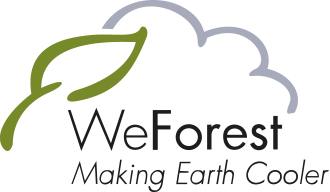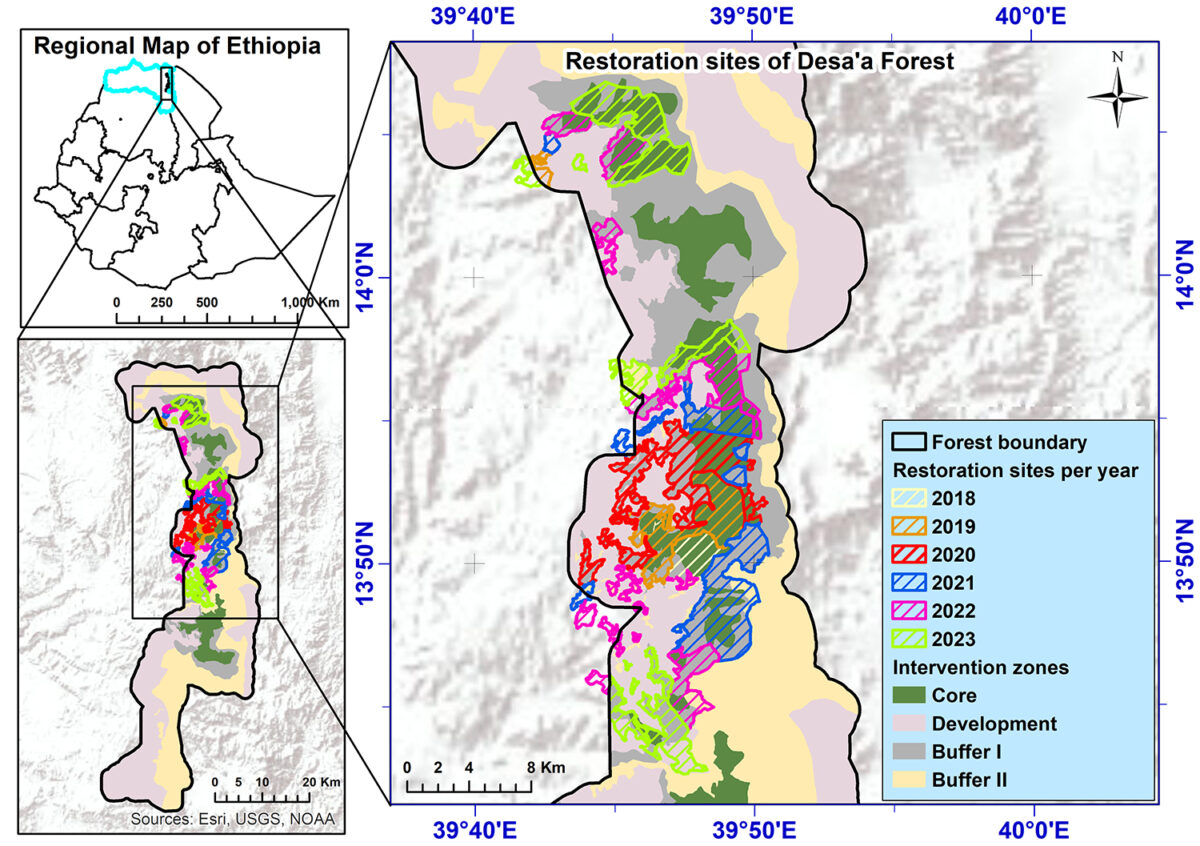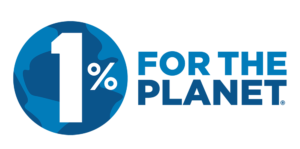
WeForest’s largest forest and landscape restoration project in Tigray, Northern Ethiopia, is aiming to bring water back to the region, halt desertification, reverse soil erosion and lift communities out of poverty.
Despite the severe drought this year, the team and the community once again met the planting and restoration goals in 2023. Almost 4619 ha (2036 ha in the core zone and 2583 in the buffer zone) was brought under restoration management – the equivalent of over 5500 football pitches. With more than 18 600 ha of forestland protected, we’re nearly halfway to restoring the 38 000 ha landscape!
Other great news this year is that the livelihoods programme, which last year was significantly impacted by the restrictions on markets, fuel, and bank closures resulting from the conflict in the region, is back on track. Almost all of its 2023 targets were met during the year.
In March, members of WeForest’s HQ were able to visit the Desa’a project for the first time since the conflict here began in 2020. They were overwhelmed and touched by the welcome they were given by the project’s local participants, many of whose lives are changing thanks to the incomes generated through the different livelihood schemes supported by WeForest.
We started to register the presence of wildlife in our restoration areas this year. So far, spotted hyenas (Crocuta crocuta) and caracal cats (Caracal caracal) have been captured on camera!
In the core zone, where forest cover is above 40%, our restoration mainly focuses on conservation management practices: strict protection from livestock and illegal human interference, and Assisted Natural Regeneration (ANR). Any planting done here is simply light gap filling, although this year, 50 kg of Vachellia abyssinica seeds were also sown here.
In the buffer zone we carry out more intensive planting, maintenance activities such as pruning, and soil and water conservation work. Protection from livestock and illegal human interference and Assisted Natural Regeneration is also done here.

Starting in May, planting pits and water harvesting structures were constructed in 2023’s planting sites. More than 1,120,250 micro basin planting pits were excavated (including pits for wild seedlings and ANR) during 2023.
This year, thanks to 2842 community members – 1630 of them women – we surpassed our planting target! More than a million seedlings of five tree species were planted, mostly in the buffer zone. Around 71 000 of these seedlings went to the core zone for gap filling.
In the seven WeForest-managed nurseries, we raised more than 1.4 million seedlings of different species. This number includes seedlings for the 2024 planting season.
Scientific name | Planted in core zone, 2023 | Planted in buffer zone, 2023 |
|---|---|---|
Olea europaea L. subsp. cuspidata (Wall. ex G. Don) Cif. | 38 400 | 403 800 |
Juniperus procera Hochst. ex Endl. | 32 750 | 564 500 |
Cytisus proliferus | – | 46 000 |
Myrica salicifolia | – | 2900 |
Rhus retinorrhoea Steud. ex Oliv. | – | 1300 |
This year, in addition to the planting, more than 245 ha of the buffer zone adjacent to communal lands and settlements was sown with 554 kg of Cytisus proliferus seeds. This species is fast-growing and serves as bee forage, livestock fodder and firewood. The seeds were collected by community members and nursery workers.
The seeds were collected by community members and nursery workers.
After planting, post-planting management practices were carried out, as every year. Almost 100k trees were pruned over more than 230 hectares of the buffer zone, resulting in 1540 donkey loads of fuelwood (estimated to be around 54 000 kg in total) collected and distributed to 287 households, 84 of them headed by women. On average, each household receives 5 donkey loads or around 188 kg each. 291 community members carried out the pruning.
7028 community members (4527 women) from Kalamin, Hawile, Felegewoyni, Mikael-Emba, Golgolnaele, Gebrekidan, Hayelom and Rubafeleg participated in other post-planting management practices such as watering and mulching.
Survival rates are still tremendous, thanks to the huge effort put into post-planting management. In 2023, we carried out survival counts on 11 plots established in the buffer zone. According to the analysis, the survival rates one year and three years after planting (i.e. from the 2020 and 2022 planting seasons) are 89% and 94.87% respectively.
Across all restoration zones we collect baseline data, against which our project performance indicators are measured. Accordingly, vegetation and soil carbon data were collected from 42 plots in the 2023 restoration areas in both the buffer and core zones. The analysis will be available soon.
Coming up nicely
These are native juniper trees we’re managing near Felegewoyni village. In the last two years alone they’ve shot up from half a metre tall to two metres!
Our Desa’a project underwent an assessment by Tigray’s Bureaus of Charity and Finance earlier this year. On 1st September, their findings were presented at a meeting in Wukro town. It was attended by members of the project’s active woredas (districts) – Atsbi, Tsrae-Wenberta and Tsaeda-Emba – as well as representatives from other restoration initiatives, researchers and local leaders.
The Bureaus praised the project for its strong collaborations with local institutions and communities, as well as for the passion, work ethic and commitment of WeForest staff. The awesome survival rates of planted seedlings in the project area was of particular note, and the assessors suggested studying the contributing factors to scale up this achievement as a best practice for the region.
Success stories from local participants were testament to the project’s impact. Improvements in household incomes were confirmed by many personal accounts, with several participants confirming that the new sources of income have reduced their dependence on forest resources. One such testimony was from a family who received 3 mature female sheep from WeForest and reached 30 sheep in 4 years. The family sold 27 of the sheep and bought a cow, and are now earning a solid income through milk sales.
“The project’s achievements, working models and monitoring has inspired us. The Desa’a project truly transforms the landscape and people positively, and this is what we should do in the future,” said one Bureau representative at the meeting.
A household survey to evaluate the impacts of our forest-friendly incomes programme was carried out in 2023. When the livelihood programmes were defined, it was with the assumption that they would generate at least US$1 per day, so that the households would be lifted out of the poverty threshold with an average daily income of $2 (the baseline household income at the time of assessment was US$1).
However, the communities have faced successive challenges for more than three years from the war and severe drought in the region in general, and in the project areas in particular. The survey found that thus far, the annual income generated by the WeForest-supported schemes ranged from US$6.45 to US$601.30 per household per year from sales alone. This makes the mean income solely from the selling of honey, eggs, etc between US$0.36 and US$0.39 per day per household.
This is a good start considering the challenges of the war since 2020 – and the fact that it’s still early days, and the livelihood programmes’ ability to generate income will continue to build year after year as flocks expand and agroforestry plots develop. However, to gauge a more accurate picture of how families are benefiting, the team also counted the value of the assets, which in most cases the participants had managed successfully to multiply. The current number of sheep in a flock, for example, is often many more than WeForest provided in the first instance.
These calculations covering both income from sales and the current market value of still available livelihood inputs showed that, for families that received the usual inputs from WeForest to start them off, their benefit from their livelihoods programme(s) is already a very healthy US$1.53 per day per family!
Check out the Desa’a map for some stories about our livelihood scheme participants that were collected at the end of 2023.
In Tigray, honey has high value. It can be easily stored and sold at the local markets and, as such, it is an ideal annual income-generating activity for poor households. In an area where 86% of households directly depend on forest resources for subsistence, developing alternative, forest-friendly sources of income like honey is an essential step toward reducing local human pressure on forest resources.
The availability of bee colonies is a challenge, and WeForest established a queen rearing hub in Kalamin/Felegweni in 2021 to address the shortage. A second hub was established during 2023 in a slightly warmer site and will support the demand from midland areas such as Mikael-Emba and Haleyom.
38 bee colonies are living in the queen rearing hubs for splitting and grafting, and we carry out regular inspections daily. To supplement the natural bee forage and floras, both short-cycle and perennial crops are planted. This year, bee forage and flora seedlings were planted over 916 m2 of both rearing hubs.
The beekeeping community members complete their in-kind labour contribution and then receive their hives. 300 bee colonies were distributed this year. Of these 300, 54 were produced through splitting and grafting in the queen rearing hubs, the latter for the first time ever in the Tigray region – an exciting achievement, and a good sign of things to come!
The year’s new beekeepers were given 5 days theoretical and practical training, including bee cloning, splitting, transferring and preparing beeswax, and they received technical assistance to plant at least 100 bee flora seedlings each.
Almost all our bees are happy to be in the project!
Sheep and goats are among the most economically important livestock in Tigray for poor households, as they are often the main sources of protein and household income. They provide more substantial income, but less frequently than chickens.
The criteria for inclusion in our small ruminant scheme is to be a woman-headed household living close to the forest. In 2023 100 women were selected in 2023, all from Kalamin, and got 3 days of training in collaboration with experts from the Office of Agriculture and Rural Development.
Each household gets 3 female sheep aged under 4, in good health and with lamb(s) or about to give birth (this is indicated by the thickness and colour of the milk). They are tagged and vaccinated before distribution.
80 out of 84 (95%) of the survey respondents who previously received sheep are still actively involved. The survey report also indicated that the households have got 8 new lambs per 10 ewes, and sheep rearers get an average annual income of US$132.90 from selling sheep.
How poultry reduces pressure on forests
Poultry is a low-input system which provides regular income while improving nutrition. The chickens are obtained within the district to increase chances of survival and adaptation (they are already used to cold climatic conditions), avoid disease transfer and provide a local market for breeders.
A thousand chickens were distributed to 100 female-headed households in 2023. 15 out of 23 (65%) of the households who received chickens in 2021 before the scheme was in hiatus during the conflict are still actively engaged, and the average income from egg sales per respondent in 2023 was US$54.80.
Agroforestry for food security
Agroforestry is a system in which specific trees or woody shrubs are mixed with crops on agricultural land. It is one of the most sustainable ways for smallholder farmers to grow cash crops for food security, nutrition and income while natural resources such as soil and water are improved by the presence of the trees, which also sequester carbon as they grow. In agroforestry plots some trees such as timber are harvested and ideally replaced. Others, such as fruit and nitrogen-fixing trees, which are often used for soil fertilization and animal fodder, are pruned year after year providing food, soil fertility and numerous other benefits.
Of the project’s 2185 agroforestry participants, the majority (1881 households) have received multipurpose tree seedlings. In 2023, we distributed more than 66 300 agroforestry seedlings from nine tree species for planting on homesteads: Cytisus proliferus, Acacia dicurrence, Acacia saligena, Vernonia amygdalina, Cupressus lusitanica, Olea europaea and Ruta chalepensis.
The remaining 304 households are in the high-value crop programme, and receive apple (Malus domestica) and “gesho” (Rhamnus prinoides) seedlings.
Alternative energy sources
Forest-dependent communities gather wood, trees, leaves and undergrowth from the forest for fuel. Combined with the use of traditional, inefficient stoves, this means the annual pressure for fuelwood is estimated to represent more than 23 000 tons. Direct fuel saving solutions are crucial for reducing the unsustainable use of fuelwood.
Our programme to distribute energy efficient cookstoves and solar lamps for local communities has been largely on hold since the war began, and we saw activities resume in 2023 with the opening of roads, markets and businesses once again. 500 cook stoves have been distributed this year, and solar lamps distributed to 1447 households. We plan to assess the impact of the cooking stoves on fuel wood consumption in the first quarter of 2024.
Distinguished visitors
At the beginning of November, the Desa’a project was honoured to receive a visit from Prof. Mitiku Haile, founder of Mekelle University and 2021 Laureate of the GCHERA (Global Confederation of Higher Education Associations for Agricultural and Life Sciences) World Agriculture Prize. He was accompanied by colleagues Dr. Abadi, previously head of the Tigray Bureau of Agriculture and Rural Development, and Dr. Girmay, a professor at Mekelle University.
With WeForest’s Ethiopia Country Director Dr. Aklilu Negussie Mekuria, the visitors discussed topics such as sustainability and carbon financing, how to scale up WeForest’s practices in other areas, research initiatives that could leverage the forest and landscape restoration in Desa’a, and what is needed from government, universities and other stakeholders to support WeForest. All the visitors were hugely impressed by what they saw, and promised to use their capacity and influence to support and promote our activities!
We establish structures before the rains – including trenches, half-moon basins, percolation ponds and terraces – to replenish groundwater, help infiltration and stop heavy topsoil from washing away. With these structures, which can be entirely built by the communities, we expect to harvest around 0.5 million m3 of water during each rainy season.
During 2023:
Every hectare under restoration is mapped with GPS points to generate polygons (areas on a map) that are assigned to sponsors. Permanent monitoring plots are established in our sites and our forestry and science teams conduct surveys to monitor progress of biomass growth, tree density, survival rate and species diversity, among other indicators. Where social impacts are also critical, we measure socio- economic indicators such as the number of beneficiaries, people trained, and income generated from forest-friendly livelihood activities.
Please visit our What We Do web page for more information.
Stay up-to-date with your interactive Desa’a map, and check out the photo album of the project on Flickr.
Thank you for supporting the Desa’a project!
HQ (BE): WeForest asbl/vzw
Cantersteen 47, 1000 Brussels, Belgium
VAT number BE0826.151.968
Incorporated May 26th 2010
WeForest is a supporting member of:





| Cookie | Duration | Description |
|---|---|---|
| __cf_bm | 1 hour | This cookie, set by Cloudflare, is used to support Cloudflare Bot Management. |
| _GRECAPTCHA | 6 months | Google Recaptcha service sets this cookie to identify bots to protect the website against malicious spam attacks. |
| cookielawinfo-checbox-analytics | 11 months | This cookie is set by GDPR Cookie Consent plugin. The cookie is used to store the user consent for the cookies in the category "Analytics". |
| cookielawinfo-checbox-functional | 11 months | The cookie is set by GDPR cookie consent to record the user consent for the cookies in the category "Functional". |
| cookielawinfo-checbox-others | 11 months | This cookie is set by GDPR Cookie Consent plugin. The cookie is used to store the user consent for the cookies in the category "Other. |
| cookielawinfo-checkbox-advertisement | 1 year | Set by the GDPR Cookie Consent plugin, this cookie records the user consent for the cookies in the "Advertisement" category. |
| cookielawinfo-checkbox-necessary | 11 months | This cookie is set by GDPR Cookie Consent plugin. The cookies is used to store the user consent for the cookies in the category "Necessary". |
| cookielawinfo-checkbox-performance | 11 months | This cookie is set by GDPR Cookie Consent plugin. The cookie is used to store the user consent for the cookies in the category "Performance". |
| CookieLawInfoConsent | 1 year | CookieYes sets this cookie to record the default button state of the corresponding category and the status of CCPA. It works only in coordination with the primary cookie. |
| elementor | never | The website's WordPress theme uses this cookie. It allows the website owner to implement or change the website's content in real-time. |
| JSESSIONID | session | New Relic uses this cookie to store a session identifier so that New Relic can monitor session counts for an application. |
| Path | session | Description is currently not available. |
| viewed_cookie_policy | 11 months | The cookie is set by the GDPR Cookie Consent plugin and is used to store whether or not user has consented to the use of cookies. It does not store any personal data. |
| Cookie | Duration | Description |
|---|---|---|
| _hjAbsoluteSessionInProgress | 1 hour | Hotjar sets this cookie to detect a user's first pageview session, which is a True/False flag set by the cookie. |
| _hjIncludedInSessionSample_2773626 | 1 hour | Description is currently not available. |
| aka_debug | session | Vimeo sets this cookie which is essential for the website to play video functionality. |
| authstrategy | session | Description is currently not available. |
| li_gc | 6 months | Linkedin set this cookie for storing visitor's consent regarding using cookies for non-essential purposes. |
| lidc | 1 day | LinkedIn sets the lidc cookie to facilitate data center selection. |
| pll_language | 1 year | Polylang sets this cookie to remember the language the user selects when returning to the website and get the language information when unavailable in another way. |
| UserMatchHistory | 1 month | LinkedIn sets this cookie for LinkedIn Ads ID syncing. |
| Cookie | Duration | Description |
|---|---|---|
| SRM_B | 1 year 24 days | Used by Microsoft Advertising as a unique ID for visitors. |
| Cookie | Duration | Description |
|---|---|---|
| _ga | 1 year 1 month 4 days | Google Analytics sets this cookie to calculate visitor, session and campaign data and track site usage for the site's analytics report. The cookie stores information anonymously and assigns a randomly generated number to recognise unique visitors. |
| _ga_* | 1 year 1 month 4 days | Google Analytics sets this cookie to store and count page views. |
| _gcl_au | 3 months | Google Tag Manager sets the cookie to experiment advertisement efficiency of websites using their services. |
| _hjFirstSeen | 1 hour | Hotjar sets this cookie to identify a new user’s first session. It stores the true/false value, indicating whether it was the first time Hotjar saw this user. |
| _hjSession_* | 1 hour | Hotjar sets this cookie to ensure data from subsequent visits to the same site is attributed to the same user ID, which persists in the Hotjar User ID, which is unique to that site. |
| _hjSessionUser_* | 1 year | Hotjar sets this cookie to ensure data from subsequent visits to the same site is attributed to the same user ID, which persists in the Hotjar User ID, which is unique to that site. |
| ajs_anonymous_id | 1 year | This cookie is set by Segment to count the number of people who visit a certain site by tracking if they have visited before. |
| ajs_group_id | 1 year | This cookie is set by Segment to track visitor usage and events within the website. |
| ajs_user_id | 1 year | This cookie is set by Segment to help track visitor usage, events, target marketing, and also measure application performance and stability. |
| AnalyticsSyncHistory | 1 month | Linkedin set this cookie to store information about the time a sync took place with the lms_analytics cookie. |
| CLID | 1 year | Microsoft Clarity set this cookie to store information about how visitors interact with the website. The cookie helps to provide an analysis report. The data collection includes the number of visitors, where they visit the website, and the pages visited. |
| CONSENT | 2 years | YouTube sets this cookie via embedded YouTube videos and registers anonymous statistical data. |
| MR | 7 days | This cookie, set by Bing, is used to collect user information for analytics purposes. |
| s_vi | 2 years | An Adobe Analytics cookie that uses a unique visitor ID time/date stamp to identify a unique vistor to the website. |
| SM | session | Microsoft Clarity cookie set this cookie for synchronizing the MUID across Microsoft domains. |
| VISITOR_PRIVACY_METADATA | 6 months | Description is currently not available. |
| vuid | 1 year 1 month 4 days | Vimeo installs this cookie to collect tracking information by setting a unique ID to embed videos on the website. |
| Cookie | Duration | Description |
|---|---|---|
| ANONCHK | 10 minutes | The ANONCHK cookie, set by Bing, is used to store a user's session ID and verify ads' clicks on the Bing search engine. The cookie helps in reporting and personalization as well. |
| bcookie | 1 year | LinkedIn sets this cookie from LinkedIn share buttons and ad tags to recognize browser IDs. |
| bscookie | 1 year | LinkedIn sets this cookie to store performed actions on the website. |
| IDE | 1 year 24 days 1 minute | Google DoubleClick IDE cookies store information about how the user uses the website to present them with relevant ads according to the user profile. |
| li_sugr | 3 months | LinkedIn sets this cookie to collect user behaviour data to optimise the website and make advertisements on the website more relevant. |
| muc_ads | 1 year 1 month 4 days | Twitter sets this cookie to collect user behaviour and interaction data to optimize the website. |
| MUID | 1 year 24 days | Bing sets this cookie to recognise unique web browsers visiting Microsoft sites. This cookie is used for advertising, site analytics, and other operations. |
| personalization_id | 1 year 1 month 4 days | Twitter sets this cookie to integrate and share features for social media and also store information about how the user uses the website, for tracking and targeting. |
| test_cookie | 15 minutes | doubleclick.net sets this cookie to determine if the user's browser supports cookies. |
| VISITOR_INFO1_LIVE | 6 months | YouTube sets this cookie to measure bandwidth, determining whether the user gets the new or old player interface. |
| YSC | session | Youtube sets this cookie to track the views of embedded videos on Youtube pages. |
| yt-remote-connected-devices | never | YouTube sets this cookie to store the user's video preferences using embedded YouTube videos. |
| yt-remote-device-id | never | YouTube sets this cookie to store the user's video preferences using embedded YouTube videos. |
| yt.innertube::nextId | never | YouTube sets this cookie to register a unique ID to store data on what videos from YouTube the user has seen. |
| yt.innertube::requests | never | YouTube sets this cookie to register a unique ID to store data on what videos from YouTube the user has seen. |
| Cookie | Duration | Description |
|---|---|---|
| __tld__ | session | Description is currently not available. |
| ajscookies | 1 year | No description available. |
| ajstest | 1 year | No description available. |
| debug | never | No description available. |